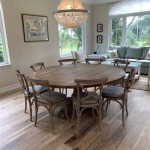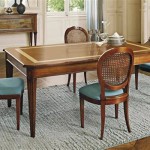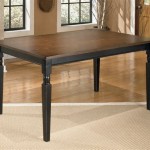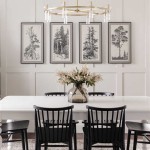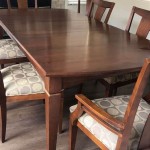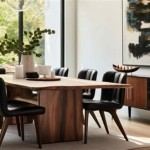Wall Decorating Ideas For Dining Room
The dining room serves as a focal point for gatherings, meals, and shared experiences. Its aesthetic appeal significantly impacts the ambiance and overall enjoyment of these activities. Wall decor, in particular, plays a crucial role in shaping the dining room's atmosphere, reflecting personal style, and creating an inviting space for family and guests. Thoughtful wall decoration can transform a mundane dining area into a visually stimulating and memorable environment.
Selecting appropriate wall decor requires consideration of several factors, including the room's size, existing furniture, lighting, and the desired mood. A cohesive design approach ensures that the wall decor complements the existing elements, contributing to a harmonious and balanced aesthetic. Disregarding these factors can result in a disjointed or overwhelming appearance, detracting from the overall dining experience.
Wall decor encompasses a wide range of options, from traditional paintings and prints to more contemporary approaches such as wall sculptures, mirrors, and decorative shelving. The choice depends on personal preference, the desired style (e.g., modern, traditional, rustic), and the function the decor is intended to serve. Certain decor elements can visually expand a small room, enhance natural light, or add a pop of color to a neutral space.
Creating a Focal Point with Artwork
Artwork serves as a primary element in dining room wall decor, capable of establishing a focal point and setting the tone for the entire space. The selection of artwork should align with the room's style and the homeowner's personal taste. Large-scale paintings or framed prints can command attention and create a sense of drama, while smaller pieces can be grouped together to form a gallery wall.
Consider the subject matter and color palette of the artwork. Landscapes, still lifes, and abstract pieces are common choices for dining rooms. The colors should complement the existing furniture and decor, either by providing a subtle contrast or by reinforcing the room's dominant hues. Avoid overly busy or distracting artwork if the goal is to create a calming and inviting atmosphere.
The placement of artwork is equally important. A large piece should be centered on a prominent wall, such as behind the dining table or opposite the entrance. The height at which the artwork is hung should be considered; generally, the center of the artwork should be at eye level. For gallery walls, plan the arrangement beforehand to ensure a balanced and visually appealing composition.
Framing plays a significant role in the overall impact of the artwork. Select frames that complement the artwork and the room's style. Simple, minimalist frames are suitable for modern spaces, while more ornate frames can enhance a traditional setting. The matting around the artwork should also be considered, as it can affect the perceived size and prominence of the piece.
Beyond traditional paintings and prints, consider alternative forms of artwork, such as textile art, photography, or even hand-painted murals. These options can add a unique and personalized touch to the dining room. Ultimately, the artwork should reflect the homeowner's individual style and create a visually stimulating and enjoyable dining experience.
Utilizing Mirrors to Enhance Space and Light
Mirrors offer a versatile and practical solution for enhancing the dining room's ambiance. They can visually expand a small space, reflect natural light, and add a touch of elegance. Strategic placement of mirrors can significantly alter the perception of the room's size and brightness, making it feel more open and inviting.
A large mirror placed on a wall opposite a window can effectively double the amount of natural light in the room. This is particularly beneficial in dining rooms that receive limited sunlight. The reflected light can brighten the space and create a more cheerful and welcoming atmosphere. Smaller mirrors can be grouped together to create a decorative effect, adding visual interest and dimension to the walls.
Consider the shape and style of the mirror. Round mirrors can soften the lines of a rectangular room, while rectangular mirrors can emphasize height and length. Ornate frames can add a touch of glamour, while simple, minimalist frames are suitable for modern spaces. The frame should complement the existing furniture and decor, ensuring a cohesive and balanced aesthetic.
Placement is crucial for maximizing the benefits of mirrors. Avoid placing mirrors directly opposite cluttered areas or visually unappealing views. Instead, position them to reflect attractive features, such as artwork, lighting fixtures, or decorative plants. A mirror placed behind a light fixture can amplify the light and create a more dramatic effect.
Beyond traditional wall-mounted mirrors, consider incorporating mirrored furniture or decorative accessories. Mirrored sideboards or console tables can add a touch of sophistication and reflect light throughout the room. Smaller mirrored accents, such as trays or candle holders, can also contribute to the overall ambiance.
When using multiple mirrors, ensure that they are appropriately spaced and balanced. Avoid creating a disorienting or chaotic effect. The goal is to enhance the space and light, not to overwhelm the eye. With careful planning and execution, mirrors can transform the dining room into a brighter, more spacious, and more inviting environment.
Incorporating Decorative Shelving for Functional Style
Decorative shelving offers a practical and stylish solution for adding visual interest and storage to the dining room walls. Shelves can be used to display decorative objects, books, plants, and other items that reflect the homeowner's personal style. They provide an opportunity to create a curated display that enhances the room's aesthetic appeal while also serving a functional purpose.
Consider the type of shelving that best suits the room's style and storage needs. Floating shelves offer a clean and minimalist look, while traditional shelving units can provide more substantial storage space. The material of the shelves should also be considered; wood shelves can add warmth and texture, while metal shelves can create a more industrial or contemporary feel.
The arrangement of items on the shelves is crucial for creating an appealing display. Group items of similar colors or textures together to create a cohesive look. Vary the height and size of the items to add visual interest. Leave some empty space to prevent the shelves from looking cluttered or overwhelming.
Incorporate a variety of decorative objects, such as vases, sculptures, picture frames, and candles. Books can also be used to add visual interest and personality. Consider the color and size of the books; arrange them by color to create a visually appealing display. Plants can add a touch of nature and freshness to the shelves.
The placement of the shelves should be carefully considered. Shelves can be used to fill empty wall space, create a focal point, or complement existing furniture. Consider the height at which the shelves are mounted; generally, the top shelf should be within easy reach. Ensure that the shelves are securely mounted and can support the weight of the items being displayed.
Beyond traditional shelving, consider alternative options, such as ladder shelves or built-in shelving units. Ladder shelves offer a unique and stylish look, while built-in shelves can provide a seamless and integrated design. Ultimately, the shelving should complement the room's style and provide functional storage space while also adding visual interest to the walls.
Consider adding lighting to the shelves to highlight the displayed items and create a more dramatic effect. Small spotlights or LED strip lights can be used to illuminate the shelves and draw attention to the decorative objects. The lighting should be subtle and complement the room's overall lighting scheme.
By carefully selecting and arranging decorative items, decorative shelving can transform the dining room walls into a visually appealing and functional display. It provides an opportunity to showcase personal style, add storage space, and enhance the overall ambiance of the room.

60 Modern Dining Room Wall Decor Ideas Designs For 2024

25 Wall Decor Ideas To Spruce Up Your Dining Room Society6

Dining Room Wall Decor Kitchen Prints The Best Memories Are Made Gathered Around Table Farmhouse Printable Art Etsy

54 Simple Dining Room Wall Decor Ideas Displate Blog

23 Dining Room Wall Décor Ideas

20 Ways To Dress Up Dining Room Walls Wall Decor Hgtv
:strip_icc()/127107347_378909933559802_5209338986625741338_n-d8e04eccf7274b2b91e5b75ec9ca40ef.jpg?strip=all)
29 Dining Room Wall Décor Ideas

Budget Friendly Dining Room Updates Hgtv

Dining Room Wall Decor Art Gather Sign For Kitchen Printable Area Black And White Etsy

Dining Room Feature Walls How I Added Character Design To The Without Decor Farmhouseish


